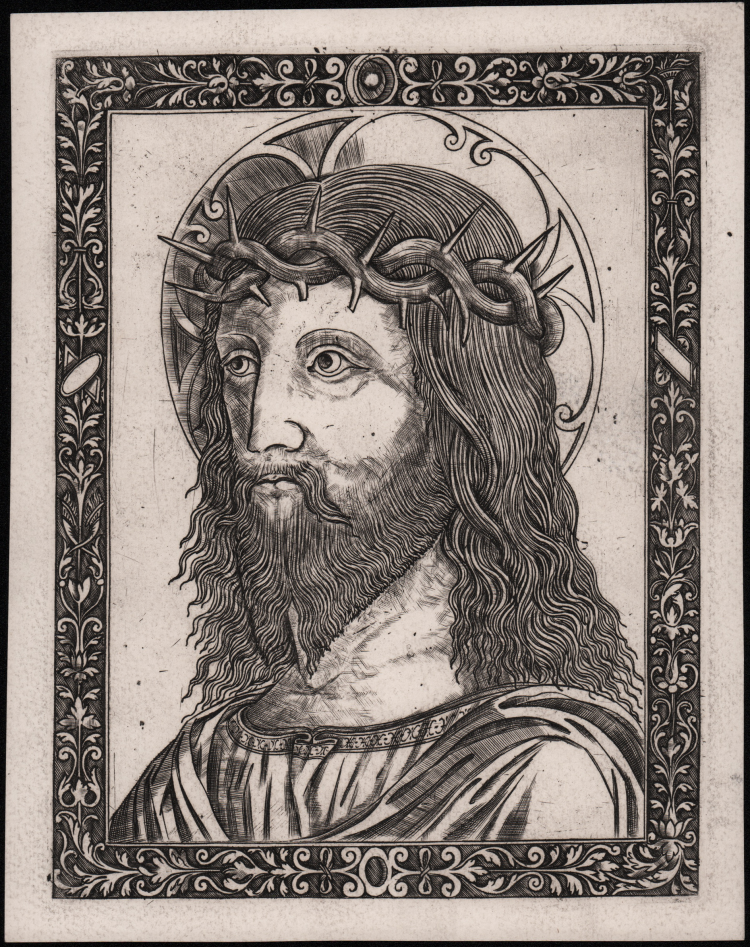




| Reference: | S42041 |
| Author | Giovanni Pietro BIRAGO |
| Year: | 1510 ca. |
| Measures: | 140 x 183 mm |



| Reference: | S42041 |
| Author | Giovanni Pietro BIRAGO |
| Year: | 1510 ca. |
| Measures: | 140 x 183 mm |
Engraving, 1510 circa, unlettered.
Known only in late impressions, the engraving was first described by Kristeller and given to the artist now conclusively identified as Giovanni Pietro Birago, whom Kristeller mistook for Fra Antonio da Monza.
With strong reservations, Hind retained the attribution (under the alias of the Master of the Sforza Book of Hours), while noting that in any case the print was evidently Milanese. In fact, it shows none of the hallmarks of Birago's personal manner, and the attribution (which appeared unlikely to Levenson et al.) must be decisively rejected. An association with the Milanese school, however, is quite acceptable. The border with a light pattern of foliage against a darkly shaded ground is similar to the ornamental pilasters in an engraving by Giovanni Maria da Brescia (TIB 2520.002), comparable ornament being found in The Crucifixion with St. Catherine of Siena and the Blessed Margaret of Hungary (.024) and in various early Milanese woodcuts (for which, see Kristeller 1913, pp. 25 and 47; Hind 1935, pp. 515 and 520; Lippmann 1888, p. 145; Alberici and De Biasi, no. 17).
More general comparison may be made with two contemporary Milanese woodcuts, iconic images of an Ecce Homo and a Christ Carrying the Cross (ill. Lippmann 1888, pp. 167 and 171); but Hind’s suggestion that the engraving was inspired by the work of Andrea Solario, an important Milanese painter of the period, is less convincing.
A fine impression on laid paper, with margins, very good condition.
Bibliografia
Hind V, 78.6; TIB, 2411.023, p. 86.
Giovanni Pietro BIRAGO (fl. 1471 – 1513)
|
Italian illuminator and engraver. In 1894 he was tentatively associated with his principal work, the Hours of Bona Sforza (British Library, London), and became known as the Master of the Sforza Book of Hours; in 1956 he was conclusively identified by his signature PSBR IO PETR BIRAGVS FT on the frontispiece of a copy (National Library, Warsaw) of Giovanni Simonetta's life of Francesco Sforza, the Sforziada, published first in Latin and then in Italian translation at Milan in 1490.
He was employed in Milan in the second half of the 15th century, building up an extensive oeuvre there. His hand can be seen in the illustrations to a number of choral books now in the Biblioteca Tosio Martinengo in Brescia, which he had already completed between 1471 and 1477 together with another miniaturist. These show that his early work was influenced by the school of Padua-Ferrara.
At around the same time as the Sforza Hours, Birago was illustrating the three books of the Sforziade, the glorification of the life of the first Francesco Sforza. In the 1490s he created miniatures in the pontifical of Bishop János Vitéz of Veszprém in Hungary. Further significant works include the Latin Grammar Book of Maximilian Sforza.
|
Giovanni Pietro BIRAGO (fl. 1471 – 1513)
|
Italian illuminator and engraver. In 1894 he was tentatively associated with his principal work, the Hours of Bona Sforza (British Library, London), and became known as the Master of the Sforza Book of Hours; in 1956 he was conclusively identified by his signature PSBR IO PETR BIRAGVS FT on the frontispiece of a copy (National Library, Warsaw) of Giovanni Simonetta's life of Francesco Sforza, the Sforziada, published first in Latin and then in Italian translation at Milan in 1490.
He was employed in Milan in the second half of the 15th century, building up an extensive oeuvre there. His hand can be seen in the illustrations to a number of choral books now in the Biblioteca Tosio Martinengo in Brescia, which he had already completed between 1471 and 1477 together with another miniaturist. These show that his early work was influenced by the school of Padua-Ferrara.
At around the same time as the Sforza Hours, Birago was illustrating the three books of the Sforziade, the glorification of the life of the first Francesco Sforza. In the 1490s he created miniatures in the pontifical of Bishop János Vitéz of Veszprém in Hungary. Further significant works include the Latin Grammar Book of Maximilian Sforza.
|